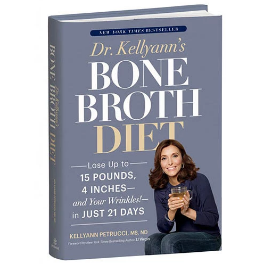
How To Make Beef Broth: Simple Homemade Recipe
Discover the transformative power of homemade beef broth, a cornerstone of nutritious and flavorful cooking. This guide invites you to delve into the simplicity and richness of crafting your own beef broth recipes, a practice cherished by traditional and ancestral diet enthusiasts. Perfect for health-conscious individuals and budget-savvy cooks alike, making beef broth at home ensures a pure, additive-free base for your culinary creations. Whether you're preparing for a week of meal prep or seeking to minimize food waste, this recipe is your gateway to a more sustainable and delicious kitchen experience.
Why Should You Make Homemade Beef Broth?
Beyond its rich, delicious taste, handmade beef broth is a satisfying endeavor with several advantages. Making your own broth helps you to manage the contents, so guaranteeing a healthy, preservative-free product fit for a lifestyle focused on wellness. Bone broth, with its collagen concentration and gut-supporting qualities, is a great supplement to any diet including keto and paleo since this procedure lets you maximize its nutritional value. Made from leftover bones and vegetable scraps to save waste and maximize flavor, homemade broth is also a reasonably priced fix for frugal cooks. Made homemade beef broth is a flexible and sustainable option that improves your culinary creativity whether you're looking for a nouraging basis for soups and stews or ready for a week of meal planning.
How To Make Beef Broth: Simple Homemade Recipe
Gather Your Ingredients
Start by assembling the essential ingredients for your homemade beef broth. You'll need beef bones, which can include marrow bones, knuckles, or oxtails, along with aromatic vegetables like onions, carrots, and celery. Add herbs such as bay leaves, thyme, and parsley for depth of flavor. Ensure you have salt and pepper on hand to season your broth to taste.
Prepare the Bones and Vegetables
Begin by roasting the beef bones in a preheated oven at 400°F (200°C) for about 30 minutes. This step enhances the flavor of your broth by caramelizing the bones. Meanwhile, roughly chop the vegetables, leaving the skins on to add extra nutrients and flavor.
Simmer the Broth
Place the roasted bones and chopped vegetables into a large stockpot. Cover them with cold water, ensuring everything is submerged. Add your herbs, seasonings, and salt, then bring the pot to a gentle boil over medium heat. Once boiling, reduce the heat to low and let the broth simmer for at least 8 to 12 hours. The longer it simmers, the richer and more flavorful it becomes.
Strain and Store
After simmering, carefully strain the broth through a fine-mesh sieve or cheesecloth into a large bowl to remove the solids. Allow the broth to cool to room temperature, then transfer it to airtight containers for storage. You can refrigerate the broth for up to a week or freeze it for several months, ensuring you always have a nutritious base ready for your culinary needs.
Enjoy Your Homemade Broth
Your homemade beef broth is now ready to enhance a variety of dishes. Use it as a base for soups, stews, and sauces, or enjoy it on its own as a nourishing drink. Revel in the satisfaction of creating a versatile, healthful ingredient that elevates your cooking and supports a sustainable kitchen.
Is Beef Stock The Same As Broth?
Beef stock and beef broth, while similar, have distinct differences that set them apart in culinary applications. Beef stock is typically made by simmering beef bones, often with some meat still attached, along with vegetables and herbs, for an extended period. This process extracts collagen from the bones, resulting in a rich, gelatinous liquid that serves as a robust base for soups and sauces. In contrast, beef broth is usually made by simmering meat, sometimes with bones, and is seasoned to be consumed on its own as a flavorful beverage or soup. Broth tends to have a lighter, more seasoned taste compared to the deeper, more concentrated flavor of stock. Both are valuable in the kitchen, but their uses may vary depending on the desired outcome of the dish.
What Additional Seasonings Can You Add?
- Garlic: Adding whole cloves or minced garlic can enhance the depth of flavor, providing a subtle aromatic quality that complements the beef.
- Peppercorns: Whole black peppercorns offer a gentle heat and complexity, infusing the broth with a warm, spicy undertone.
- Ginger: Fresh slices of ginger can introduce a hint of warmth and zest, balancing the richness of the beef with a refreshing note.
- Cloves: A few whole cloves can impart a sweet, earthy aroma, adding a unique dimension to the broth's flavor profile.
- Star Anise: This spice provides a mild licorice flavor, which can add an exotic twist and enhance the overall complexity of the broth.
How Long Does It Take To Make Beef Broth?
The process of making beef broth is a time-honored tradition that requires patience to achieve its full depth of flavor and nutritional benefits. Typically, preparing beef broth involves simmering the ingredients for a minimum of 8 to 12 hours. This extended cooking time allows the flavors to meld and the nutrients, particularly collagen, to be extracted from the bones, resulting in a rich and nourishing broth. While the preparation and initial setup may take only a short time, the long simmering period is crucial for developing the broth's robust taste and healthful properties. For those seeking an even more concentrated flavor, some choose to simmer their broth for up to 24 hours, ensuring a deeply satisfying culinary foundation.
What Is The Best Cooking Method For Beef Broth?
The best cooking method for beef broth involves a slow and gentle simmering process, which allows the flavors and nutrients to be fully extracted and developed. This method typically begins with roasting the beef bones to enhance their flavor through caramelization. Once roasted, the bones, along with aromatic vegetables and herbs, are placed in a large stockpot and covered with cold water. Bringing the mixture to a gentle boil and then reducing it to a low simmer for an extended period—usually between 8 to 12 hours—ensures that the collagen and minerals are thoroughly extracted, resulting in a rich, gelatinous broth. This slow cooking method not only maximizes flavor but also preserves the nutritional integrity of the ingredients, making it the preferred approach for creating a wholesome and flavorful beef broth.
How Can You Use Homemade Beef Broth?
- Soup Base: Use homemade beef broth as a flavorful foundation for a variety of soups, from classic beef and vegetable to more exotic pho or ramen, enhancing their depth and richness.
- Stews and Casseroles: Incorporate the broth into stews and casseroles to add moisture and a robust, savory flavor that complements the other ingredients.
- Sauce and Gravy: Reduce the broth to create a concentrated base for sauces and gravies, perfect for drizzling over meats and vegetables to elevate your dishes.
- Cooking Grains: Substitute water with beef broth when cooking grains like rice, quinoa, or barley to infuse them with a savory taste, making them more flavorful and satisfying.
- Braising Liquid: Use the broth as a braising liquid for meats and vegetables, ensuring they remain tender and absorb the rich flavors during the slow cooking process.
Conclusion
Crafting your own beef broth is a rewarding endeavor that not only enriches your culinary creations with valuable cooking tips but also aligns with a health-conscious and sustainable lifestyle. By embracing this traditional cooking method, you gain control over the ingredients, ensuring a wholesome, preservative-free product that supports gut health and enhances the flavor of your dishes. Whether you're a seasoned home cook or a beginner, the process of making beef broth offers an opportunity to connect with time-honored practices while enjoying the benefits of a versatile kitchen staple. From soups and stews to sauces and grains, homemade beef broth is a testament to the power of simple, nourishing ingredients in elevating everyday meals.
Final Thoughts
Have you ever considered the benefits of incorporating bone broth into your diet? Dr. Kellyann's premium bone broths, available in chicken, beef, and French onion varieties, provide a delicious and health-conscious option. These broths are rich in collagen, non-GMO, and sugar-free, making them perfect for fasting and aiding in your body's recovery. Discover Dr. Kellyann's extensive range of wellness products to support your journey towards optimal health and vitality.
Sources









